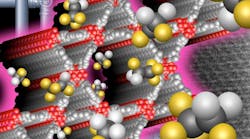When the weather heats up, so does power demand for air conditioners and refrigerators. But what if you could cool things down by using heat itself instead of electricity? That’s the idea behind adsorption cooling, which does its job without a power-hungry compressor. Researchers at the Pacific Northwest National Laboratory are developing new materials that can boost the efficiency of adsorption coolers.
Such coolers depend on a solid adsorbent and refrigerant which transform heat into energy for cooling when they interact. This process can be driven by waste heat from an industrial plant, for example, or heat from the sun, but the compatibility of the adsorbent and refrigerant determines how well it works.
Researchers at PNNL have already made strides building adsorbents from metal-organic frameworks (MOFs), porous compounds that adsorb, or “host,” certain refrigerants in the linings of their internal pores. Now, for the first time, they have tested a series of MOFs to see how well they pair with a common refrigerant, the fluorocarbon R134a. According to the researchers, the adsorption levels are among the highest seen yet.
“The pores can be tuned for size and shape to get different results, depending on the application,” says Radha Motkuri, a senior PNNL research scientist. “We are constantly looking for materials that have high refrigerant capacities and can be regenerated thousands of times.”
The researchers tested five types of MOFs. All five displayed high R134a saturation capabilities, but one in particular—the zirconium-based NU-1000—showed exceptional fluorocarbon uptake, adsorbing 170% of its weight, one of the highest values yet seen for MOFs. The results show promise for developing smaller cooling units that use less refrigerant, which could save costs and lower greenhouse gas emissions.
“Higher adsorbing capacity directly translates into more compact and efficient cooling devices,” says Pete McGrail, who has led PNNL’s adsorption cooling effort for several years. “This is because the heat exchangers used to construct a ‘thermal compressor,’ the heart of the adsorption cooling system, can be reduced in size and cycled faster due to less structural mass.”
Hydrofluorocarbons such as R134a have replaced chlorofluorocarbons as refrigerants because they do not damage the ozone layer, but they are still potent greenhouse gases. The future of cooling will involve methods that require less energy and alternative refrigerants with minimal greenhouse potential—an ambitious goal, considering global energy demand for air conditioning is expected to triple by 2050. Next, the researchers want to test MOFs in a pilot-scale cooling device.

